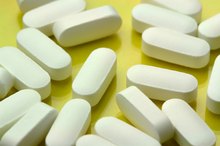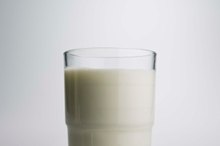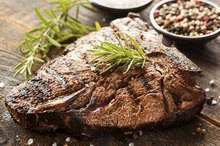What does fact checked mean?
At Healthfully, we strive to deliver objective content that is accurate and up-to-date. Our team periodically reviews articles in order to ensure content quality. The sources cited below consist of evidence from peer-reviewed journals, prominent medical organizations, academic associations, and government data.
The information contained on this site is for informational purposes only, and should not be used as a substitute for the advice of a professional health care provider. Please check with the appropriate physician regarding health questions and concerns. Although we strive to deliver accurate and up-to-date information, no guarantee to that effect is made.
How to Get 1500 Milligrams of Calcium Per Day
Calcium is a key nutrient for strong bones and overall physical health. Ohio State University says that calcium is the most abundant mineral in the body, with most calcium found in the bones and teeth and the rest in the blood and tissue cells, where it regulates important metabolic functions 1. Most healthy adults should get between 1,000 and 1,500 mg calcium per day, states the University of Michigan Health System 1. There are many dietary ways to meet your daily requirement of calcium.
Include Dairy
Drink milk to increase calcium intake. Milk is a rich source of calcium, with an 8-oz. glass of milk containing about 300 mg of calcium, according to the University of Michigan Health System 1. Include a glass of milk with each meal and you will meet more than half your daily calcium needs.
Calcium & Interstitial Cystitis
Learn More
Consume other dairy foods as well. Yogurt, cheese, cottage cheese and pudding are all good sources of calcium, with yogurt providing about 350 mg per serving, most hard cheeses about 200 mg and cottage cheese and pudding each providing about 150 mg.
Use more dairy foods in cooking and baking. Make oatmeal and creamy soups with milk instead of water to add 150 to 300 extra mg of calcium per serving. Replace oil with plain yogurt in brownie and muffin recipes to add up to 300 mg of calcium to the entire batch. Ohio State University says that many recipes can handle the addition of up to 1/2 cup of powdered milk, including meatloaf, many casseroles, macaroni and cheese, muffins, pancakes and biscuits. This provides an extra 750 mg of calcium to the entire recipe.
- Drink milk to increase calcium intake.
- Make oatmeal and creamy soups with milk instead of water to add 150 to 300 extra mg of calcium per serving.
Use Nondairy Sources
The Calcium Content of Goat's Milk
Learn More
Eat calcium-rich nondairy foods as well. The American Dietetic Association states that other foods besides dairy are additional sources of calcium. Beans, legumes, almonds, dark leafy greens, canned fish, broccoli, tofu and sesame seeds provide dietary calcium. Beans range from 20 to 240 mg of calcium per serving depending on type, and legumes provide about 30 to 80 mg per serving. Almonds and sesame seeds each provide about 80 mg per serving. Leafy greens' calcium content also varies according to type, ranging from 100 to 250 mg per serving. Broccoli provides about 35 mg per serving. Tofu contains about 260 mg calcium per serving but can contain up to 700 mg if calcium is used in its processing.
Add calcium-fortified foods to your diet. Certain types of orange juice, soy milk, almond milk, breads and cereals have added calcium, generally about 160 mg in fortified bread, up to 260 mg in fortified cereal and 300 mg in fortified juices and nondairy milks. Look for these items in your grocery store to further increase your calcium intake.
Take a calcium supplement. If you are unable to consume up to 1,500 mg of calcium through food sources alone, a calcium supplement can help, according to MayoClinic.com.
Tips
Because dairy foods can be high in fat, opt for lower-fat or fat-free versions of these foods for optimal health.
- Eat calcium-rich nondairy foods as well.
- Tofu contains about 260 mg calcium per serving but can contain up to 700 mg if calcium is used in its processing.
Related Articles
References
- Ohio State University Extension: Calcium for Better Health
- New York State Department of Health: The Food Pyramid
- Bolland, MJ, et. al. Calcium supplements with or without vitamin D and risk of cardiovascular events: reanalysis of the Women's Health Initiative limited access dataset and meta-analysis. BMJ. 2011 Apr 19;342:d2040. DOI: 10.1136/bmj.d2040
- Reid IR. The roles of calcium and vitamin D in the prevention of osteoporosis. Endocrinol Metab Clin North Am. 27: 389-398. DOI:10.1016/s0889-8529(05)70011-6
- Chen M, Pan A, Malik VS, Hu FB. Effects of dairy intake on body weight and fat: a meta-analysis of randomized controlled trials. The American Journal of Clinical Nutrition. 2012;96(4):735-747. DOI:10.3945/ajcn.112.037119
- Williams V, Rawat A, Vignesh P, Shandilya JK, Gupta A, Singh S. Fc-gamma receptor expression profile in a North-Indian cohort of pediatric-onset systemic lupus erythematosus: An observational study. Int J Rheum Dis. 2019;22(3):449-457. doi: 10.6061/clinics/2012(07)22
- Reid IR, Birstow SM, Bolland MJ. Calcium and Cardiovascular Disease. Endocrinol Metab (Seoul). 2017;32(3):339-349. doi: 10.3803/EnM.2017.32.3.339
- MedlinePlus Medical Encyclopedia, "Milk-alkali syndrome"
- Bolland MJ, Grey A, Avenell A, Gamble GD, Reid IR. Calcium supplements with or without vitamin D and risk of cardiovascular events: reanalysis of the Women’s Health Initiative limited access dataset and meta-analysis. BMJ. d2040-d2040. DOI:10.1136/bmj.d2040
- Chan Soo Shin, et. al. Endocrinol Metab (Seoul). 30(1): 27–34. DOI: 10.3803/EnM.2015.30.1.27
- Linus Pauling Institute. Calcium.
- National Institute of Health Office of Dietary Supplements. Calcium.
- Weingarten MAMA, Zalmanovici Trestioreanu A, Yaphe J. Dietary calcium supplementation for preventing colorectal cancer and adenomatous polyps. Cochrane Database of Systematic Reviews 2008, Issue 1. Art. No.: CD003548. DOI: 10.1002/14651858.CD003548.pub4
- Zemel, MB et. al. Calcium and dairy acceleration of weight and fat loss during energy restriction in obese adults. Obes Res. 2004 Apr;12(4):582-90. DOI: 10.1038/oby.2004.67
Tips
- Because dairy foods can be high in fat, opt for lower-fat or fat-free versions of these foods for optimal health.
Writer Bio
Shannon Hyland-Tassava has more than 16 years experience as a clinical health psychologist, wellness coach and writer. She is a health columnist for the "Northfield (Minn.) News" and has also contributed to "Motherwords," "Macalester Today" and two essay anthologies, among other publications. Hyland-Tassava holds a Ph.D. in clinical psychology from the University of Illinois.









